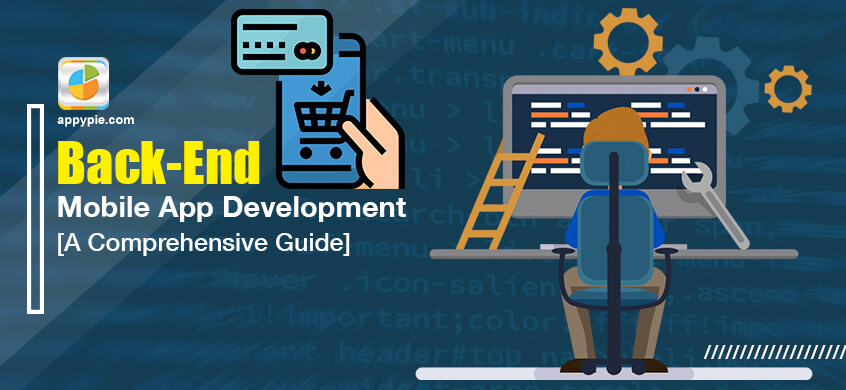A Quick Introduction to Backend Technologies & Mobile App Backend Development

As someone, who is on their journey of building a mobile app for business, there are certain important questions that must be asked even before taking the first concrete step. Let’s take a look at some of these questions:
- Would your app save any information related to the app users?
- Would your app need to display any dynamic data based on in-app user behavior?
- Would your app include user authentication, or would it need to have any admin-driven configuration functionality?
If your answer to even one of these questions was ‘Yes’, you would most probably need a back-end application programming interface or a back-end API to access the back-end resources for your mobile app. Typically, majority of the back-end architectures follow the MVC pattern i.e. Model, View, Controller. What I am going to try here is, put forth the basics of the back end of a mobile app so that you get a clearer idea of what it is actually all about.
Backend – what it includes?
Backend development is the ‘behind the scenes’ part of web development. Back-end developers are responsible for creating the actual logic on which an app or a website works. A back-end developer should have certain skills like in-depth knowledge of the back-end programming language or framework, accessibility and security compliance, a fair understanding of front-end technologies like HTML, CSS and the ability to manage a hosting environment and more.
To put it simply, back end development includes any kind of development that does not involve and coding that produces a user interface.
At the most basic level, the core of a conventional back-end architecture consists of an application server, web server, and a database. In case of an architecture that is growth oriented, it might also include a load balancer and quite a few service integrations like email notifications, push notifications, and queuing services. What you would actually need in the backend of your mobile app depends almost entirely on what kind of functionality and features you want to be integrated in it.
Here’s the list of top back-end development tools you must know:
- Language and frameworks
- Web servers
- Database management systems
- Microservice platforms
- Local development environments
- Collaboration services
- Website performance testers
Language and frameworks
As you are building the software or the back-end, you would have to work with multiple programming languages and frameworks. Now, frameworks are basically libraries of pre-written code with a pre-imposed structure that can be used by backend developers as per their requirements. A programming language, however, is a superset of all scripting languages like Ruby, Java, Python, PHP, Perl, Erlang, and Node.js that may be used for writing instructions for their implementation.
If you are looking for more information on web development languages and frameworks, then you may enjoy reading one of our earlier posts that talks about the most popular web development frameworks.
Web servers
To put it quite simply, web servers are programs that store, process, and deliver web pages to the users. The communication between client and server is carried out with the use of HTTPS. In this context, the pages most commonly delivered are most commonly HTML documents, which may include images, style sheets and scripts apart from the conventional text content. Any computer that is supposed to host any website must have web server programs. The leading examples include Apache, Microsoft’s IIS, and NGINX. Some other names on this list may include NetWare server, Google Web Server and IBM’s family of Domino servers. Web servers most commonly come as a part of a comprehensive package of internet and intranet related programs for serving emails, downloading requests for File Transfer Protocol (FTP) files, and for creating and publishing web pages.
Top 5 Web Servers for Back-End Development
- Apache HTTP Server
- Apache Tomcat
- NGINX
- js
- Lighttpd
Database management systems
A database management system of DBMS is a collection of programs that let their users access a database, manipulate, interpret, and represent data. A strong DBMS makes it possible for the users to create, access, edit, and delete data in the database. It basically acts as a connection between the database and end users, making sure that the data is organized consistently and can be accessed with ease. A typical DBMS takes care of three critical things viz. the data, the database engine that lets the data to be accessed, locked and modified, and the database schema that defines the logical structure of the database. The three basic elements of the DBMS come together to help provide concurrency, security, data integrity, and uniform administration procedures. A DBMS is the single most useful resource for offering a centralized view of data which can be accessed by multiple users, from multiple locations in a controlled manner.
Top Database Management Systems for Back-end Development
- Oracle RDBMS
- IBM DB2
- Altibase
- Microsoft SQL Server
- SAP Sybase ASE
- Teradata
- ADABAS
- MySQL
- FileMaker
- Microsoft Access
- Informix
- SQLite
- PostgreSQL
- Amazon RDS
- MongoDB
- Redis
- CouchDB
- Neo4j
- OrientDB
- Couchbase
- Toad
- phpMyAdmin
- SQL Developer
- Sequel PRO
- Robomongo
- DbVisualizer
- Hadoop HDFS
- Cloudera
- MariaDB
- Informix Dynamic Servers
- 4D (4th Dimension)
Microservice platforms
Microservices are a unique technique for software development that is a variation of the service-oriented architecture or SOA architectural style that is characterized by structuring and application as a collection of loosely coupled services. In this style of architecture there are fine-grained services and lightweight protocols. The biggest benefit of such structuring is that the modularity is enhanced. Hence the application designed as such is easier to understand, build, and test. Architectures based on Microservice facilitates continuous delivery and deployment.
Top Microservice Platforms for Back-End Development
- Docker
- Kubernetes
- WildFly Swarm
- Spring Boot
Local development environments
Any back-end developer worth their salt would tell you how crucial a local test environment is when it comes to development. When you use a local site which is only visible to you, you get the unique advantage of having the liberty to try out codes and experiments before going live with the site. When you keep tweaking the code on a local environment till you attain perfection, you ensure that your live site does not crash because of any erroneous codes or bugs in it.
A local development environment allows you to setup a server environment on your own machine, in place of making use of the hosting company’s server. Ideally when you work with a local development environment, you would not really be working on your site live, but on the browser, it would look like it is live. In fact, your browser would essentially be referencing the files that are stored locally on your machine. This means that no one else would be able to access or see what your site looks like.
Top Local Development Environments for Back-end Development
- XAMPP
- WampServer
- Laragon
Collaboration services
When there is development work going on, the back-end and front-end developers work in unison. For this to happen, it is important that the developers on both the sides to stay connected to each other and for that, collaboration services are crucial. Collaboration services make it possible for the developers from both ends to work well together, by offering useful, reliable, and intuitive communication tools.
Top Collaboration Services for Back-End Development
- Slack
- Asana
- Jira
- Skype
- Google Hangouts
- Trello
- New Relic
- Munin
- Nagios
- TeamMeta
- Redmine
Website performance testers
The attention span has dwindled down to a mere 8 seconds today. Hence the load speed of your site has a great impact on the site traffic. Even a second’s delay can send your site visitors packing. This is why speed tester tools like Google PageSpeed Insights and Full-Page Load Tester are considered almost as important as the back-end development tools by the developers. Not only do these tools provide reports of the site speed but also suggest little tweaks or edits that can help you make your page go faster.
Top Website Performance Testers for Back-end Development
- Apache Bench
- Siege
- io
- Bees with Machine Guns
- Multi-Mechanize
- Httperf
- JMeter
- Google PageSpeed Insights
- io
- org
- GTMetrix
- Pingdom
- Gomez
- FeedTheBot
- Dotcom Monitor
- Alertra
- Which Loads Faster
- Load Impact
- RedBot
- Uptrends
- OctaGate Site Time
- Neustar Ultratools
- com
- ManageWP
- LoadNinja
- StresStimulus
- LoadUI Pro
- LoadView
- NeoLoad
- WebLOAD
- Automai Performance Testing
- RedLine13
- Apache Jmeter
- HP Performance Tester
- Silk Performer
- Rational Performance Tester
- SmartMeter.io
Backend Technology – what does it mean?
Any dynamic application mobile or otherwise would require data synchronization across platforms, in addition to the ability to send alerts and notification messages and to support various HTTP methods. It is the backend of the application that establishes the limits of these abilities while helping you manage them better.
Backend APIs – handling the security
The foundation of the security for backend APIs lies in getting a robust secure sockets layer or SSL. It is possible that you may not be able to handle it all on your own, you may not even be familiar with the whole concept of SSL and in that case, it is important that you talk to someone who does.

When you consult an expert in this arena, they can ensure that all the necessary safety features are implemented in a suitable manner. Apart from SSL, two other major pillars of security for the back-end APIs viz. API token integration and authentication, and while discussing the security aspects you must consider including these as well.
Backend Stack – deployment in the cloud
The power of the cloud is being recognized and acknowledged by everyone who is even remotely associated with any kind of mobile app development. The modern age cloud computing services offer a scalable distributed architecture which are definitely going to be a big help in the growth scenarios when you are scaling up the application and are adding new users. There are multiple cloud platforms today that are essentially growth based, and hence offer multitude of services that can come in handy when it comes to scalability and growth.
Backend technology essentially lays the foundation for app development and must be chosen wisely, keeping in view multiple factors like the desired functionality, the platform, and target users. Backend tech stacks involve a lot more than just the programming languages and here’s how you can go and choose the perfect one for your mobile app. Here is how you can choose the best technology stack for your mobile app development.
Related Articles
- 5 Things You Should Know Before Developing A Hybrid App in 2019
- A Guide to On-Demand Delivery Apps
- Bumble – The Multi-Functional Dating App [A Case Study]
- Origin, History & Design Power of Neon Colors
- How to design a ticket for your event?
- Marketing Tools for B2B Companies
- What makes NFTs valuable?
- How to Make an Infographic in 7 Simple Steps? [With Elements and Tools]
- Major MailChimp Integrations for Workflow Automation
- Instagram vs Facebook: The Battle of Brothers
Most Popular Posts
 Photoshop Alternatives: Top 10 Graphic Design Tools in 2024
Photoshop Alternatives: Top 10 Graphic Design Tools in 2024 By Deepak Kumar | July 25, 2024
 Canva vs Appy Pie Design – Which is Better?
Canva vs Appy Pie Design – Which is Better? By anupam | July 18, 2024
 Canva Alternatives: Top 15 Graphic Design Tools to Replace Canva in 2024
Canva Alternatives: Top 15 Graphic Design Tools to Replace Canva in 2024 By anupam | July 18, 2024
 Canva Review: Key Features, Pros, Cons & Pricing
Canva Review: Key Features, Pros, Cons & Pricing By anupam | July 18, 2024
 8 Best ManyChat Alternatives in 2024
8 Best ManyChat Alternatives in 2024 By Samarpit Nasa | July 12, 2024

